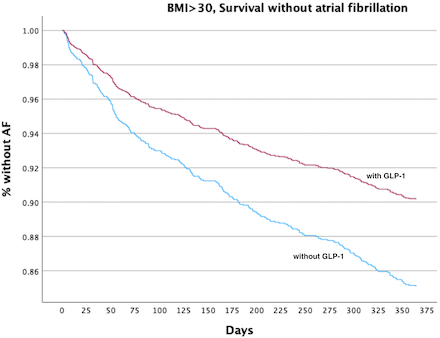Final ID: MDP1716
Impact of GLP-1 Agonist on the Incidence of Atrial Fibrillation in Obese Patients Following Heart Failure Hospitalization
Abstract Body (Do not enter title and authors here): Introduction: Atrial fibrillation (AF) in patients with heart failure (HF) is associated with increased morbidity and mortality. Glucagon-like peptide-1 (GLP-1) agonists have been shown to reduce cardiovascular risk in patients with obesity and diabetes, respectively. Meta-analysis of prospective trials looking at GLP-1 agonist use on the incidence of AF suggest benefit in patients with diabetes but is of unclear benefit in this regard for patients with obesity.
Hypothesis: GLP-1 agonists reduce atrial fibrillation incidence in patients with diabetes and obesity.
Aims: The goal of the study is to assess the effects of GLP-1 agonist on incidence of new AF in patients with obesity and diabetes following heart failure hospitalization.
Methods: The study included consecutive patients who were admitted to an academic tertiary care center over three years with a primary diagnosis of heart failure exacerbation and no prior diagnosis of AF. The primary outcome was incidence of AF within 12 months after hospitalization. Demographic, comorbidity, echocardiography, and medications were obtained. Cox-regression analysis was performed to identify the predictors of new-onset AF following HF hospitalization.
Results: Of the patients included in our study, 1668 (42.9%) have a BMI greater than or equal to 30, 574 (14.5%) have BMI greater than or equal to 40, and 2300 (58.2%) have diabetes mellitus. GLP-1 use is associated with a significantly lower incidence of AF at one year in obese patients (p=0.042; RR 0.73; 95% CI: 0.54-.99) (Figure), while in non-obese individuals, GLP-1 receptor agonist was not associated with a decreased incidence of AF (p=0.674; RR 1.08; 95% CI: 0.76-1.53). In patients with diabetes, GLP-1 receptor agonist use did not reach statistical significance for reduced AF incidence following heart failure hospitalization (p=0.091; RR 0.80; 95% CI 0.62-1.04).
Conclusion: GLP-1 receptor agonist use is associated with a statistically significant reduction of incidence of new atrial fibrillation at one year following hospitalization for heart failure in obese patients.
Hypothesis: GLP-1 agonists reduce atrial fibrillation incidence in patients with diabetes and obesity.
Aims: The goal of the study is to assess the effects of GLP-1 agonist on incidence of new AF in patients with obesity and diabetes following heart failure hospitalization.
Methods: The study included consecutive patients who were admitted to an academic tertiary care center over three years with a primary diagnosis of heart failure exacerbation and no prior diagnosis of AF. The primary outcome was incidence of AF within 12 months after hospitalization. Demographic, comorbidity, echocardiography, and medications were obtained. Cox-regression analysis was performed to identify the predictors of new-onset AF following HF hospitalization.
Results: Of the patients included in our study, 1668 (42.9%) have a BMI greater than or equal to 30, 574 (14.5%) have BMI greater than or equal to 40, and 2300 (58.2%) have diabetes mellitus. GLP-1 use is associated with a significantly lower incidence of AF at one year in obese patients (p=0.042; RR 0.73; 95% CI: 0.54-.99) (Figure), while in non-obese individuals, GLP-1 receptor agonist was not associated with a decreased incidence of AF (p=0.674; RR 1.08; 95% CI: 0.76-1.53). In patients with diabetes, GLP-1 receptor agonist use did not reach statistical significance for reduced AF incidence following heart failure hospitalization (p=0.091; RR 0.80; 95% CI 0.62-1.04).
Conclusion: GLP-1 receptor agonist use is associated with a statistically significant reduction of incidence of new atrial fibrillation at one year following hospitalization for heart failure in obese patients.
More abstracts on this topic:
6-Nitrodopamine potentiates the positive chronotopic and inotropic effect induced by noradrenaline in the rat isolated heart
Lima Antonio, Sobanski Joao Fernando, Antunes Edson, De Nucci Gilberto
A short version of HFD/L-NAME mouse model enabling time-effective proof of concept studies to evaluate drugs targeting the cardiometabolic and mild hypertension associated HFpEF phenotype.Assaly Rana, Dubroca Caroline, Waget Aurelie, Perrier Kevin, Sulpice Thierry

